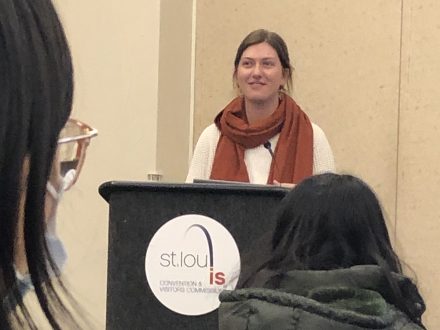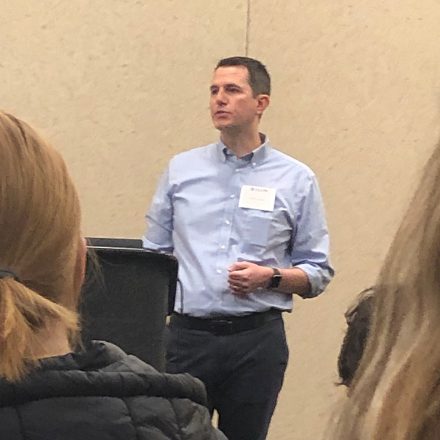Colin Donohue, Kelly Furnas and Megan Curling ’23 presented educational sessions while the School of Communications also ran a sponsorship table at the annual convention that welcomed approximately 3,200 attendees.
Two faculty members, two students and one staff member from the School of Communications participated in the Journalism Education Association/National Scholastic Press Association National High School Journalism Convention Nov. 10-13 in St. Louis. Approximately 3,200 students, advisers, educators and vendors attended the JEA/NSPA convention, billed as the largest gathering of student journalists in the country.

Colin Donohue ’05, director of student engagement and special projects in the School of Communications, and Tommy Kopetskie, communications manager, ran a sponsorship table with Elon students Megan Curling ’23 and Gianna Smurro ’25. The quartet talked with high school students and advisers, highlighting Elon University, the institution’s curriculum and academic initiatives, and the Emerging Journalists Program.
Senior Lecturer Kelly Furnas attended the convention as an invited speaker, presenting two sessions: “Covering the unimaginable” and “Better, faster, stronger storytelling.” The well-attended sessions addressed Furnas’ experience as a student media adviser at Virginia Tech during its mass shooting 15 years ago, as well as delving into steps to becoming a more efficient and creative storyteller.

Donohue also presented a session, titled “The shapes of stories,” exploring how to incorporate story arcs into nonfiction writing. Lastly, Curling was one of only a handful of student presenters and shared advice on how to approach health stories with sensitivity and data-focused reporting. Her session was titled “Essentials of health reporting.”
Below are their session descriptions from the program.
Session topics
Covering the unimaginable
Kelly Furnas
In the 15 years since the Virginia Tech shootings, student journalists have covered unimaginable tragedies at their schools, often with depth and staying power far beyond their professional counterparts. Learn about the ethical and practical considerations behind preparing to cover a story you hope you never have to.

The shapes of stories
Colin Donohue
Overcoming the monster. From rags to riches. The hero’s quest. Story arcs are beautiful and elegant, and they help us understand why stories resonate with an audience. Using a series of commercials, we’ll explore how to incorporate these arcs into your nonfiction writing.
Better, faster, stronger storytelling
Kelly Furnas
Learn how to become a more efficient and creative storyteller by examining every step of story development — from pitching and planning to sourcing and writing. This session will cover how you can captivate your broadcast, online and print audiences.

Essentials of health reporting
Megan Curling
Covering health has never been more important, and this session will teach you how to approach your stories with sensitivity and data-focused reporting. Whether your future involves journalism or medicine, come learn how to equitably tell stories about the health issues affecting your community.
About the National High School Journalism Convention
The convention is an annual gathering of high school journalists, advisers and journalism educators. It features hundreds of practical and professional learning sessions in addition to contests and Pacemaker awards. The educational experiences are geared toward all media types – newspaper, online, broadcast, yearbook and magazine – and include topics useful to students, advisers and teachers.


